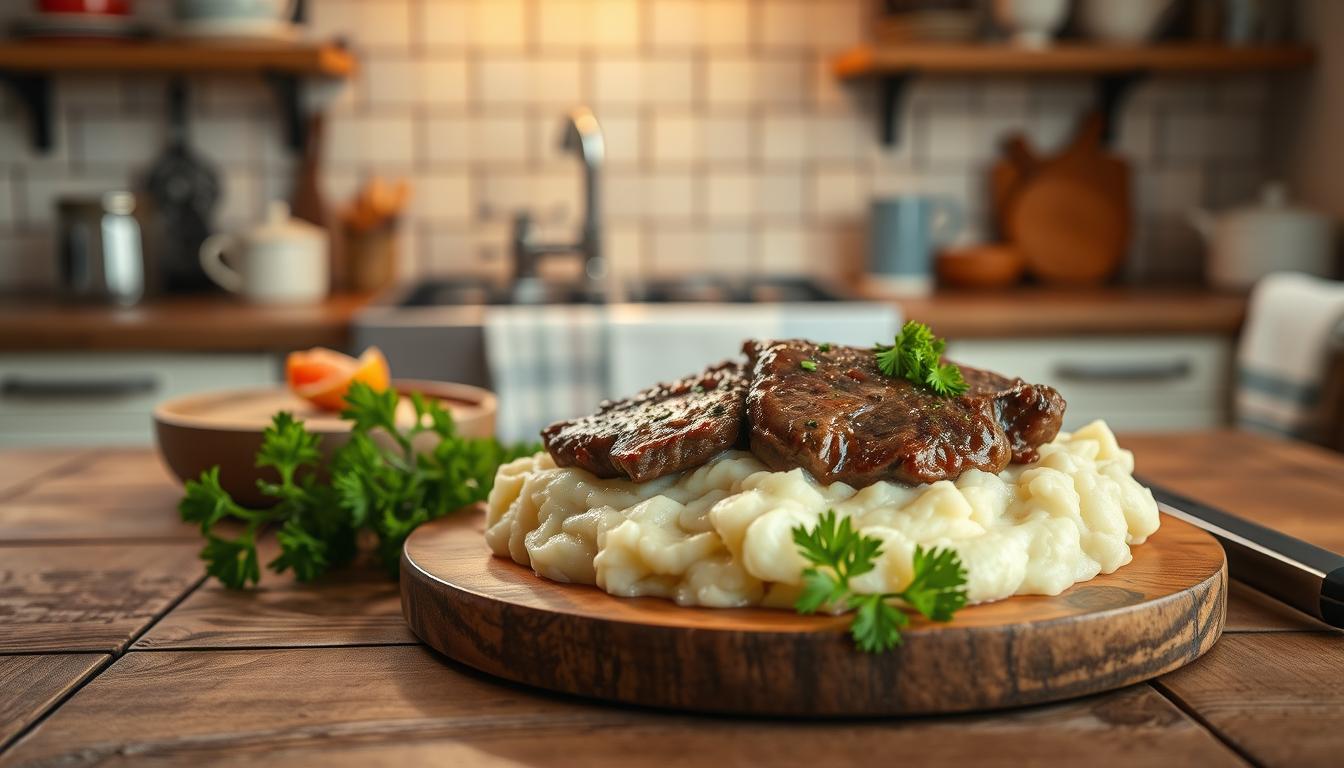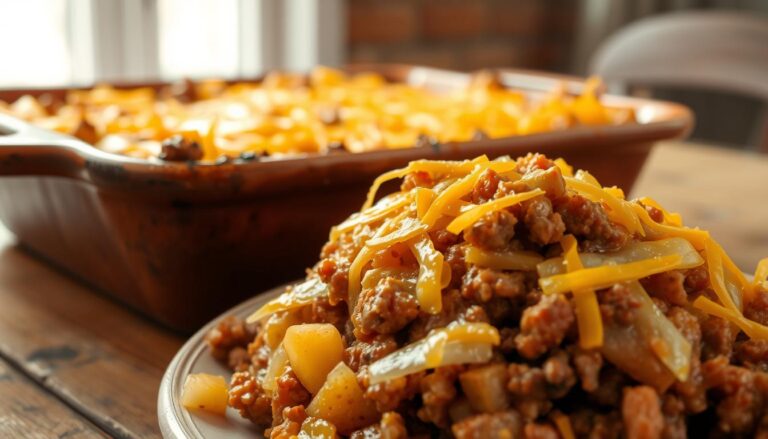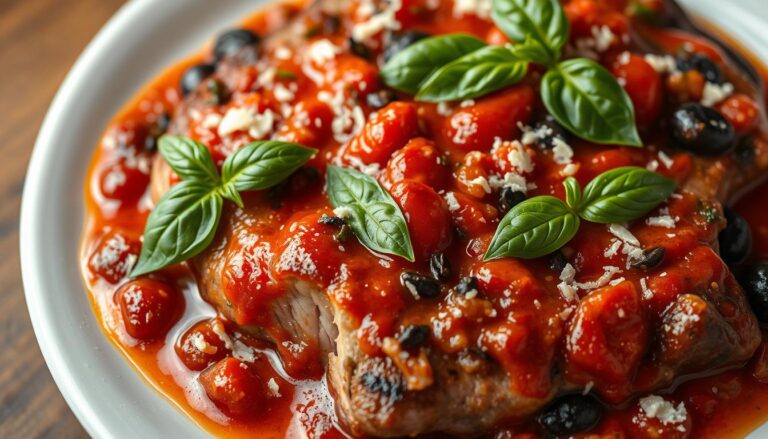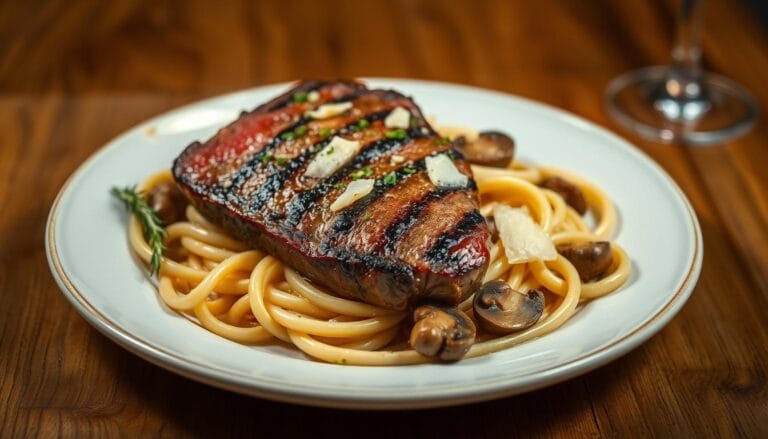How to Make the Best Swiss Steak Recipe
Growing up in a small Midwestern kitchen, I learned that some of the most memorable meals aren’t fancy. They’re the comfort foods that warm your soul. Swiss steak has always been that magical dish for my family. It transforms an ordinary cut of beef into a tender, rich masterpiece that brings everyone to the table.
This classic swiss steak recipe is more than just a meal. It’s a culinary hug that turns tough beef cuts into a mouthwatering comfort food experience. Whether you’re cooking for a busy family dinner or wanting to recreate a nostalgic childhood favorite, this recipe promises pure deliciousness.
Today, I’ll guide you through creating the most incredible swiss steak. Your family will be asking for seconds. From selecting the perfect beef cut to mastering the rich tomato gravy, you’ll become a swiss steak expert in no time.
Table of Contents
Understanding Swiss Steak: Origins and History
Swiss steak is a classic American dish with a name that might surprise you. It has no connection to Switzerland. The name “Swiss” actually comes from a special way of tenderizing meat.
Why It’s Called “Swiss” Steak
The name “Swiss” comes from the meat tenderizing method called “swissing.” This method uses pounding or rollers to soften meat. Later, beef braising techniques were added, making the dish a favorite in American homes.
- Original meaning: Mechanical meat tenderizing
- Process: Pounding or rolling meat to soften texture
- Goal: Create more tender beef cuts
Traditional Preparation Methods
Home cooks used beef braising to make tough meat cuts tasty. They coated the beef in flour, browned it, and then slow-cooked it in a rich tomato sauce. This made the meat incredibly tender.
Evolution of the Recipe
Over time, Swiss steak went from a budget-friendly meal to a comfort food favorite. Different families added their own touches to the recipe. But they kept the core tenderizing and braising techniques that make it special.
Essential Ingredients for Classic Swiss Steak Recipe
Starting an authentic Swiss steak means picking the right ingredients. Your tomato gravy is the dish’s heart, turning simple parts into a delicious meal. It will wow your family and friends.
The main ingredients for a tasty Swiss steak are:
- Beef cuts (round or chuck steak)
- All-purpose flour for coating
- Vegetable oil for browning
- Fresh vegetables for onion stew base
- Canned tomatoes
- Beef broth
Your onion stew needs aromatic veggies like:
- Yellow onions
- Carrots
- Celery
Seasoning is key for deep, rich flavors. Key spices and condiments include:
- Worcestershire sauce
- Garlic powder
- Paprika
- Salt and black pepper
Choosing top-notch, fresh ingredients makes your Swiss steak stand out. Each part adds special flavors and textures. This turns the classic dish into a memorable meal.
Choosing the Right Cut of Beef
Choosing the right beef cut is key for a tasty Swiss steak. The meat you pick can greatly affect the dish’s flavor and softness.
For Swiss steak, pick affordable cuts that are full of flavor and tender. The right cut can turn your meal into something special, like a restaurant dish.
Top Round vs Chuck Steak: A Comparison
Knowing the differences between beef cuts is important:
- Top Round: Lean and economical, perfect for Swiss steak
- Chuck Steak: More marbled, slightly more expensive
- Cube Steak: Pre-tenderized and budget-friendly option
Understanding Meat Quality
| Cut | Tenderness | Price Range | Best For |
|---|---|---|---|
| Top Round | Medium | $ | Swiss Steak |
| Chuck Steak | Low | $$ | Slow Cooking |
| Cube Steak | High | $ | Quick Preparation |
Budget-Friendly Options
Pro tip: Cube steak is often the most wallet-friendly choice for your Swiss steak recipe. Most grocery stores offer pre-tenderized cube steak. This saves you time and ensures consistent results for your budget meal.
When shopping, look for sales and consider buying in bulk to reduce per-pound costs. Buying larger quantities and freezing portions can help you make delicious meals while keeping your food budget in check.
Proper Meat Tenderizing Techniques
Meat tenderizing is key to making Swiss steak tender. Knowing the right methods can greatly improve your cooking.
Here are some effective ways to tenderize meat at home:
- Mechanical tenderizing with a meat mallet
- Using specialized meat tenderizing tools
- Marinating with acidic ingredients
- Cutting against the meat grain
Begin by picking the right beef cut. Top round or bottom round steaks are great for Swiss steak. Wrap the meat in plastic wrap or wax paper to avoid splatters.
| Tenderizing Method | Effectiveness | Time Required |
|---|---|---|
| Meat Mallet | High | 10-15 minutes |
| Acidic Marinade | Medium | 2-4 hours |
| Cutting Against Grain | Medium | 5 minutes |
To achieve the best results, pound the meat to ½ inch thickness. This ensures it cooks evenly and stays tender. A meat mallet with textured sides is best for tenderizing.
Pro tip: If you don’t have a meat mallet, a heavy skillet or rolling pin works too. The goal is to apply consistent, firm pressure to break down the meat’s fibers.
Step-by-Step Swiss Steak Recipe
Making the perfect swiss steak recipe needs care and patience. It turns tough beef into a tender, tasty dish that everyone will love. Cooking it slow in a dutch oven or large skillet is key.
Preparation Time and Cooking Duration
Working on your swiss steak recipe takes time. Here’s what you should expect:
- Prep Time: 15-20 minutes
- Cooking Time: 2-3 hours
- Total Time: Approximately 3 hours
Temperature Guidelines
Getting the right temperature is important for a tender steak. Here are the temperatures you need:
| Cooking Stage | Temperature | Duration |
|---|---|---|
| Initial Searing | Medium-High (400°F) | 3-4 minutes per side |
| Slow Cooking | Low (350°F) | 2-3 hours |
Essential Equipment Needed
For a real swiss steak, you’ll need certain tools:
- Dutch oven or heavy-bottomed skillet
- Sharp chef’s knife
- Meat tenderizer
- Cutting board
- Measuring cups and spoons
“The secret to a perfect swiss steak is patience and the right cooking technique.” – Professional Chef
Choosing the right dutch oven is crucial. Cast iron ones distribute heat well and add deep flavor to your swiss steak.
Creating the Perfect Tomato Gravy Base
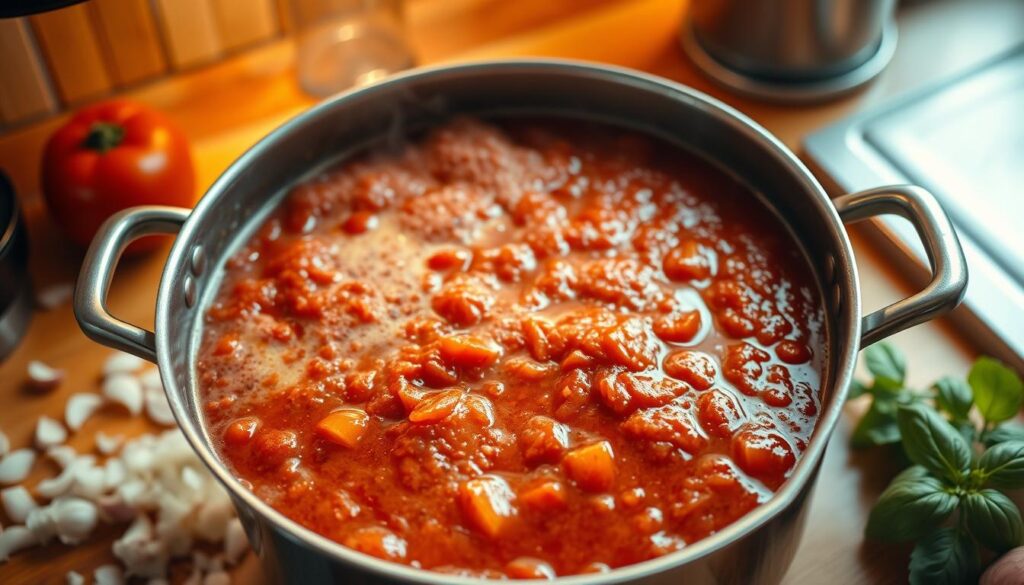
Making a great tomato gravy is key to making your Swiss steak amazing. It adds depth, richness, and a tangy taste that makes every bite better.
Start with top-notch ingredients for your tomato gravy. Chefs say to use:
- San Marzano canned diced tomatoes
- Rich beef broth
- Fresh garlic and onions
- Worcestershire sauce
- Dried herbs like thyme and oregano
For a perfect tomato gravy, balance acidity and richness. Begin by cooking minced garlic and onions until they’re soft. Deglaze the pan with beef broth to get those tasty browned bits.
“A great tomato gravy is like a culinary symphony – each ingredient plays a crucial role in creating harmony.” – Chef Michael Rodriguez
To get the right consistency, simmer your tomato gravy slowly. This lets the flavors blend and get stronger. If it’s too thin, a bit of cornstarch slurry can thicken it without losing the tomato taste.
Pro tip: Season your tomato gravy slowly and taste it as you go. A little sugar can balance the tomatoes’ acidity, making the flavor more complete.
Dutch Oven vs Slow Cooker Methods
Cooking Swiss steak can be done in two main ways. You can choose between a dutch oven or slow cooking. Your decision depends on your time, kitchen setup, and what you like.
Both dutch oven and slow cooking have their own benefits for Swiss steak. Knowing the differences helps you pick the best method for your kitchen.
Temperature and Cooking Time Considerations
The cooking temperatures and times are different for dutch oven and slow cooking:
- Dutch Oven: High-heat method with direct oven exposure
- Slow Cooker: Low and slow approach with consistent temperature
| Cooking Method | Temperature | Cooking Duration |
|---|---|---|
| Dutch Oven | 325°F | 2.5 – 3 hours |
| Slow Cooker | Low Setting | 7 – 8 hours |
Benefits of Each Cooking Technique
Dutch oven cooking is faster and can make the edges crispy. Slow cooking, on the other hand, makes the meat very tender and is easy to prepare.
“The right cooking method can turn an ordinary cut of meat into an extraordinary meal.” – Professional Chef
Choosing between dutch oven and slow cooking depends on your schedule, the texture you want, and your cooking style. Both ways will make a delicious Swiss steak that will wow your guests.
Vegetable Combinations and Flavor Enhancers
Adding the right vegetables to your onion stew can make your Swiss steak amazing. Classic recipes use a mix of veggies that add depth and richness.
The key to a great Swiss steak vegetable mix is:
- Sweet yellow onions
- Crisp celery
- Vibrant orange carrots
Want to try something new in your onion stew? Here are some exciting veggie options that add unique tastes:
- Root vegetables: Parsnips and turnips add an earthy sweetness
- Aromatic additions: Celeriac root has a subtle nutty flavor
- Umami boosters: Sliced mushrooms add a rich, meaty taste
- Colorful options: Bell peppers add flavor and color
When picking veggies for your Swiss steak, think about how they work with the meat and sauce. Aim for a mix that boosts the dish’s flavor. Cut your veggies the same size for even cooking and texture.
Pro tip: Roasting or caramelizing some veggies before adding them to the steak can make them sweeter. This adds more flavor layers to your onion stew.
Tips for Achieving Fork-Tender Results
Perfecting beef braising takes patience and skill. Your Swiss steak can go from tough to tender with the right slow cooking methods. It’s all about understanding how meat breaks down and using the right techniques for tenderness.
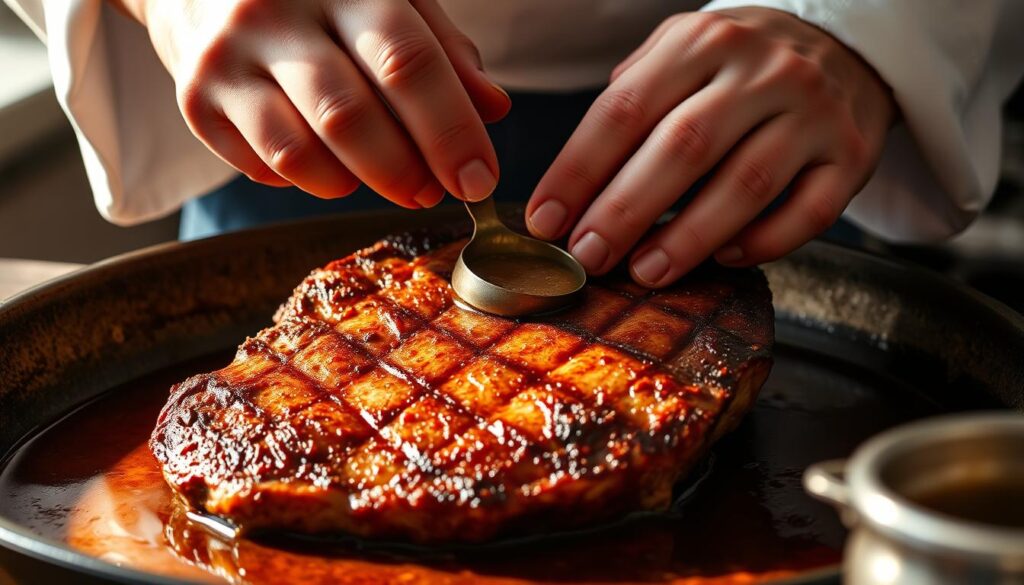
Getting that melt-in-your-mouth texture is more than just cooking time. It’s about the technique. Slow cooking breaks down tough fibers, making the dish soft and easy to shred.
Common Cooking Mistakes to Avoid
- Cutting meat against the grain too early
- Using high heat during beef braising
- Skipping the tenderizing process
- Overcrowding the cooking vessel
When slow cooking, keeping the temperature low is key. This helps break down tissues without drying out the meat.
Testing for Doneness
Figuring out when your Swiss steak is just right needs careful watching. Here are some tips:
- Fork Test: Meat should easily pull apart when prodded
- Internal Temperature: Aim for 145°F for medium-rare
- Cooking Time: Expect 45 minutes to 1.5 hours depending on cut
“Patience is the secret ingredient in creating fork-tender beef.” – Professional Chef
Remember, beef braising is an art that needs careful attention and gentle cooking. Your slow cooking will turn an ordinary cut into a special meal.
Best Side Dish Pairings
Choosing the right side dishes can make Swiss steak a memorable meal. Its rich flavor and tender texture need the right match.
Classic side dishes are a great start for your comfort food meal. Here are some top picks:
- Creamy mashed potatoes
- Buttered egg noodles
- Steamed white rice
- Roasted seasonal vegetables
Want to make your Swiss steak meal even better? Try these creative sides:
| Side Dish | Flavor Profile | Preparation Difficulty |
|---|---|---|
| Garlic Parmesan Polenta | Creamy, Rich | Medium |
| Roasted Butternut Squash | Sweet, Earthy | Easy |
| Cauliflower Gratin | Cheesy, Decadent | Medium |
Your side dish choice can really improve your meal. Pro tip: Pick sides that soak up the tomato gravy from your Swiss steak. This way, you won’t miss out on any flavor.
The best comfort food meals balance taste and variety. Try different sides to find your favorite Swiss steak match.
Storage and Reheating Guidelines
Keeping your tasty budget meal fresh is easy. Swiss steak is great for leftovers, keeping its flavor and quality.
Here’s how to store your Swiss steak right:
- Refrigeration: Store in an airtight container with the sauce
- Maximum refrigerator storage: 3-4 days
- Freezer storage: Up to 3 months
Reheating is key to keeping your meal tender. Here are the best ways to warm up your Swiss steak:
- Oven Method: Preheat to 350°F, cover with foil, heat for 20-25 minutes
- Stovetop Method: Use low heat, add a splash of broth to prevent drying
- Microwave: Use 50% power, cover, and heat in short intervals
Thawing needs time. Always thaw frozen Swiss steak in the fridge a day before reheating. This ensures even heating.
| Storage Method | Duration | Best Practices |
|---|---|---|
| Refrigerator | 3-4 days | Use airtight container, keep sauce with meat |
| Freezer | Up to 3 months | Wrap tightly, remove excess air from container |
By using these storage and reheating tips, you can enjoy your Swiss steak in many delicious meals. This way, you get more flavor and value.
Conclusion
Your journey into Swiss steak recipe is more than learning to cook. It’s about making a comfort food that brings families together. This dish is tender, delicious, and full of rich flavors.
The Swiss steak recipe lets you try new things. You can use different ingredients and cooking methods. This makes your dish truly special.
Learning to make Swiss steak is about mastering meat selection, tenderizing, and slow cooking. It’s not just about following a recipe. It’s about growing your cooking skills and making a meal that warms your heart.
Cooking Swiss steak for family, friends, or yourself is special. Remember, the more you cook, the better you’ll get. Don’t be shy to change seasonings, add different veggies, or try new cooking ways.
We encourage you to share your Swiss steak stories, ask questions, and keep exploring cooking. Your kitchen is a place of creativity. This recipe is just the start of your cooking journey.

